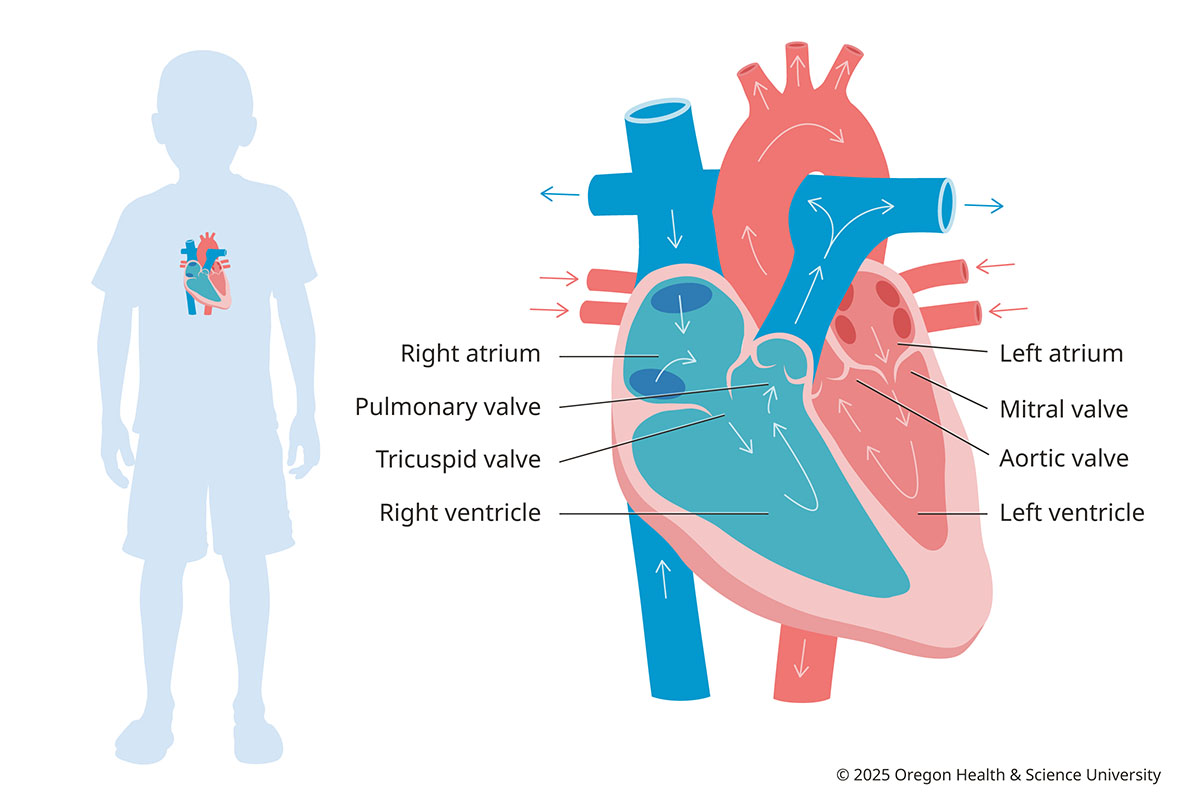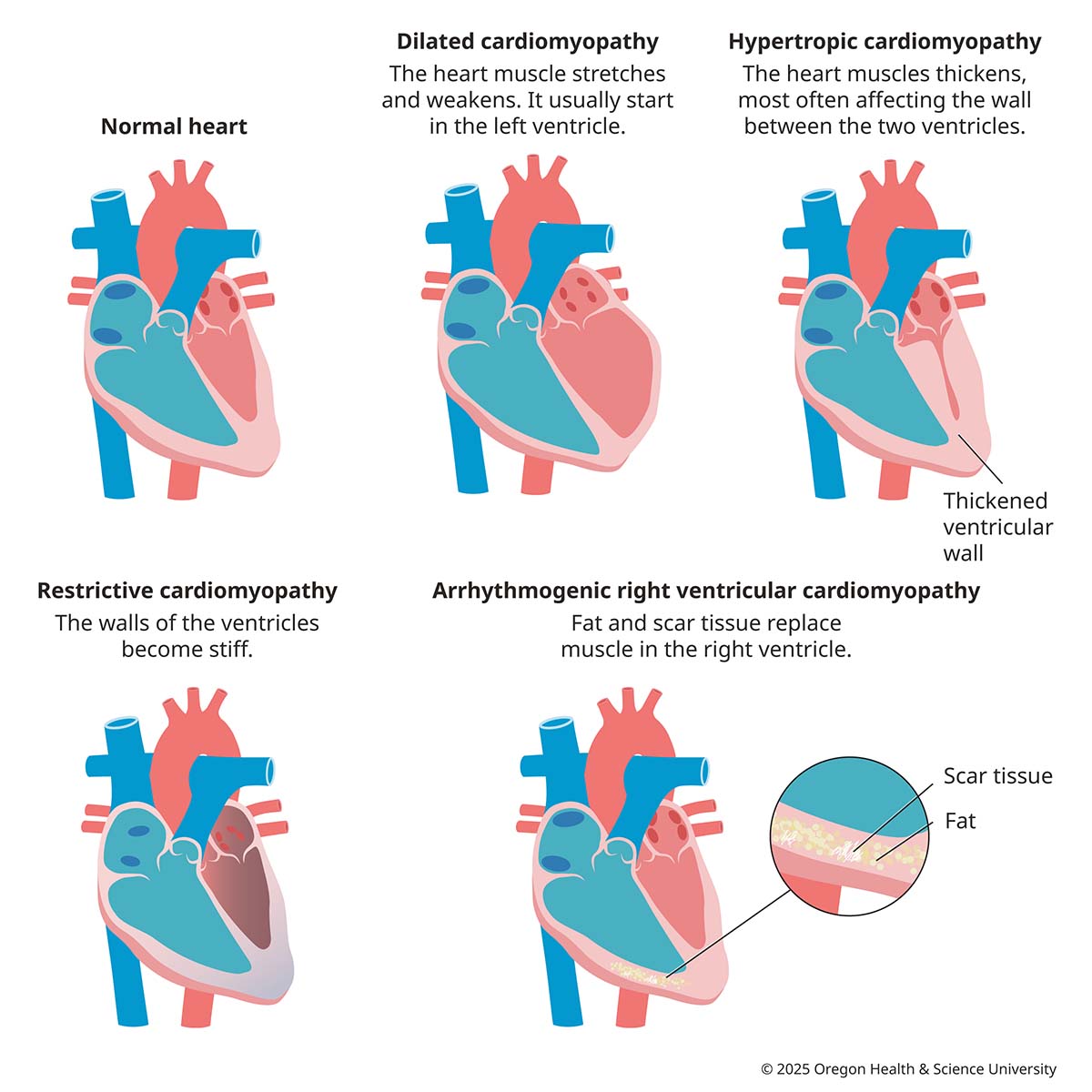Acquired Heart Conditions in Children

At OHSU Doernbecher Children’s Hospital, you’ll find complete care for children’s acquired heart conditions. OHSU is the first Oregon center, for example, with a specialty program to treat hypertrophic cardiomyopathy.
We offer:
- Children’s heart experts who are available 24/7.
- A team-based approach to caring for children at high risk for these complex conditions.
- Monitoring for pregnant women with chronic conditions that can affect the baby’s heart.
- Close cooperation with specialists at OHSU’s Knight Cardiovascular Institute.
Find links to more information about acquired heart conditions on our Resources for Patients and Families page.
Understanding acquired heart conditions
What are acquired heart conditions?
Acquired heart conditions are issues with your child’s heart that develop after birth. They can be caused by illnesses such as a bacterial or viral infection. They can also be the result of chronic diseases or medications that affect other areas of the body.
Who gets acquired heart conditions?
Acquired heart disease is much less common in children than in adults. It’s also different in children and adults. Adults are most likely to develop coronary artery disease, in which blood vessels to the heart narrow. In children, the coronary arteries may or may not be affected.
Main types of acquired heart conditions
To best understand the following conditions, it might help to review the “How the heart works” section on our Understanding Pediatric Heart Conditions page.
The Heart Anatomy and Blood Flow, Pediatric

Kawasaki disease
Kawasaki disease is one of the most common causes of acquired heart conditions in children. Most children recover completely. The disease causes inflammation of the coronary arteries that deliver oxygen-rich blood to the heart. The artery walls can balloon or bulge, a condition called an aneurysm.
Symptoms: The first symptoms (acute phase) last 10 to 14 days and include:
- Fever
- Spotty rash on the back, chest, abdomen or groin
- Red eyes or sensitivity to light
- Swollen hands, feet or tongue
- Cracked lips
- Swollen lymph nodes in the neck
- Joint pain or swelling
Treatment: Patients are treated with medication and follow-up care. All children with Kawasaki disease have at least two echocardiograms to evaluate the heart and coronary arteries. A small portion of children need additional tests and treatments.
Rheumatic heart disease
Rheumatic heart disease is damage to the heart valves caused by rheumatic fever, an inflammatory disease that affects the heart, skin, joints and brain.
Rheumatic fever most often results from strep throat that was not fully treated with antibiotics. Strep throat is common, but rheumatic fever is extremely rare in the U.S.
Signs of rheumatic heart disease can begin soon after a strep infection or years later. Over time, heart valves can become inflamed and scarred, leading to narrowing or leaking.
Treatment: Options include medication and, if needed, surgery to replace or repair a damaged valve.
Myocarditis, pericarditis and endocarditis
These are types of heart inflammation. Causes can include a viral or bacterial infection, cancer, or an autoimmune disease such as lupus or rheumatoid arthritis.
Myocarditis: The heart muscle (myocardium) becomes inflamed. It often heals on its own. A severe case can weaken a child’s heart, possibly leading to abnormal heart rhythms, blood clots or heart failure.
Pericarditis: The sac that surrounds the heart (pericardium) becomes irritated or inflamed. Most cases are mild and need only over-the-counter treatment. In rare cases, too much fluid builds in the pericardium, the sac that surrounds the heart.
Endocarditis: This is an infection that usually invades the heart valves. Most often, it is caused by a bacterial infection. It’s rare but more common in children with congenital heart disease or valve conditions.
Signs and symptoms: Depending on the area of the heart affected, signs and symptoms may include:
- Fever or chills
- Weakness, fatigue or feeling sick
- Fainting
- Shortness of breath or rapid breathing
- Arrhythmia (irregular heartbeat)
- A new heart murmur or changes to an existing one
- Night sweats
- Chest pain
- Heart palpitations
- Pain or shortness of breath when lying down
Treatment: In many cases, heart inflammation improves on its own. For other patients, treatment options include medication and/or surgery.
Cardiomyopathy

Cardiomyopathy is a disease of the heart’s muscle fibers. The heart becomes stiff, thickened or enlarged. Cardiomyopathy is rare in children. It can be hereditary (genetic) or caused by other health conditions or treatments.
Types:
- Hypertrophic cardiomyopathy: The heart muscle becomes abnormally thickened. We offer complete care for hypertrophic cardiomyopathy in cooperation with the Knight Cardiovascular Institute. OHSU’s hypertrophic cardiomyopathy program is the first in Oregon. It’s also the only one in the Northwest named a Center of Excellence by the Hypertrophic Cardiomyopathy Association.
- Dilated cardiomyopathy: The left ventricle becomes enlarged and can’t pump blood as effectively. Fluid may build up in the lungs and other parts of the body.
- Restrictive cardiomyopathy: The heart muscle becomes less elastic, making it less able to expand and fill between heartbeats.
- Arrhythmogenic right ventricular cardiomyopathy: In this rare condition, the muscle of the right ventricle is replaced by fat and scar tissue. Symptoms of arrhythmogenic right ventricular cardiomyopathy, such as irregular heart rhythms, may not be noticed until adulthood.
Symptoms: Specific symptoms vary by type, but common ones include:
- Shortness of breath
- Swollen legs, ankles and feet
- Abdominal bloating or pain
- Cough while lying down
- Fatigue
- Rapid, pounding or fluttering heartbeat
- Chest pressure or pain
- Dizziness
- Fainting
Treatments: Treatments vary depending on the type of cardiomyopathy and can range from medication to surgery. Genetic evaluation, if needed, is offered for types of cardiomyopathies that run in families. Learn about our complete care for pediatric cardiomyopathy.
For families
Call 503-346-0640 to:
- Request an appointment.
- Seek a second opinion.
- Ask questions.
Locations
Parking is free for patients and their visitors.
Doernbecher Children’s Hospital
700 S.W. Campus Drive
Portland, OR 97239
Map and directions
Find other locations across Oregon and in southwest Washington.
Refer a patient
- Refer your patient to OHSU Doernbecher.
- Call 503-346-0644 to seek provider-to-provider advice.